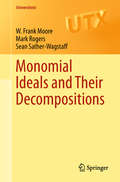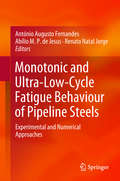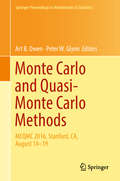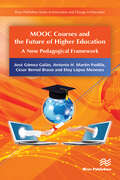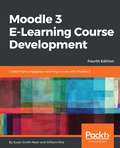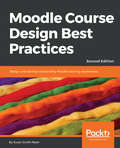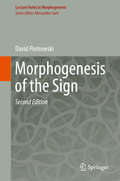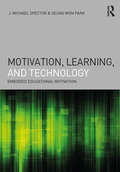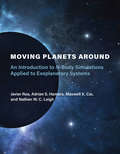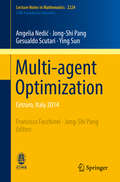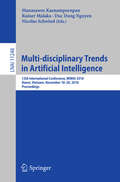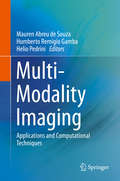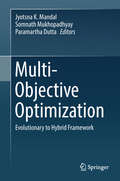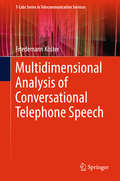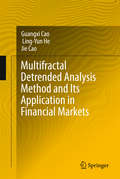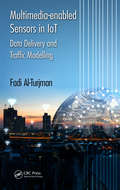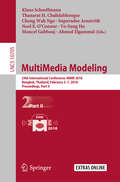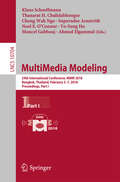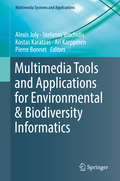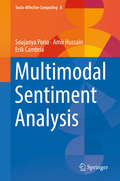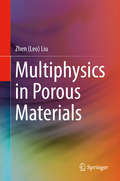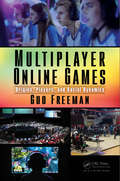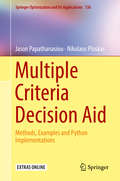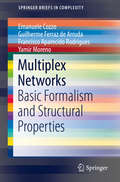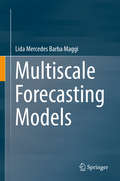- Table View
- List View
Monomial Ideals and Their Decompositions (Universitext)
by W. Frank Moore Mark Rogers Sean Sather-WagstaffThis textbook on combinatorial commutative algebra focuses on properties of monomial ideals in polynomial rings and their connections with other areas of mathematics such as combinatorics, electrical engineering, topology, geometry, and homological algebra. Aimed toward advanced undergraduate students and graduate students who have taken a basic course in abstract algebra that includes polynomial rings and ideals, this book serves as a core text for a course in combinatorial commutative algebra or as preparation for more advanced courses in the area. The text contains over 600 exercises to provide readers with a hands-on experience working with the material; the exercises include computations of specific examples and proofs of general results. Readers will receive a firsthand introduction to the computer algebra system Macaulay2 with tutorials and exercises for most sections of the text, preparing them for significant computational work in the area. Connections to non-monomial areas of abstract algebra, electrical engineering, combinatorics and other areas of mathematics are provided which give the reader a sense of how these ideas reach into other areas.
Monotonic and Ultra-Low-Cycle Fatigue Behaviour of Pipeline Steels: Experimental and Numerical Approaches
by António Augusto Fernandes Abílio M.P. Jesus Renato Natal JorgeThis book covers the development of innovative computational methodologies for the simulation of steel material fracture under both monotonic and ultra-low-cycle fatigue. The main aspects are summarised as follows: i) Database of small and full-scale testing data covering the X52, X60, X65, X70 and X80 piping steel grades. Monotonic and ULCF tests of pipe components were performed (buckled and dented pipes, elbows and straight pipes). ii) New constitutive models for both monotonic and ULCF loading are proposed. Besides the Barcelona model, alternative approaches are presented such as the combined Bai-Wierzbicki-Ohata-Toyoda model. iii) Developed constitutive models are calibrated and validated using experimentally derived testing data. Guidelines for damage simulation are included. The book could be seen as a comprehensive repository of experimental results and numerical modeling on advanced methods dealing with Ultra Low Cycle Fatigue of Pipelines when subjected to high strain loading conditions.
Monte Carlo and Quasi-Monte Carlo Methods: Mcqmc 2016, Stanford, Ca, August 14-19 (Springer Proceedings in Mathematics & Statistics #241)
by Art B. Owen Peter W. GlynnThis book presents the refereed proceedings of the Twelfth International Conference on Monte Carlo and Quasi-Monte Carlo Methods in Scientific Computing that was held at Stanford University (California) in August 2016. These biennial conferences are major events for Monte Carlo and quasi-Monte Carlo researchers. The proceedings include articles based on invited lectures as well as carefully selected contributed papers on all theoretical aspects and applications of Monte Carlo and quasi-Monte Carlo methods. Offering information on the latest developments in these very active areas, this book is an excellent reference resource for theoreticians and practitioners interested in solving high-dimensional computational problems, arising in particular, in finance, statistics, computer graphics and the solution of PDEs.
MOOC Courses and the Future of Higher Education: A New Pedagogical Framework
by José Gómez Galán Antonio H. Padilla César Bernal BravoDuring the last decades, our society is witnessing an authentic revolution that, in a dizzying manner has deeply influenced, modified, and transformed the way of life of human beings. This constant and unstoppable revolution is transmuting all areas of our life: social, cultural, personal, labor, economic, training, etc. This new society is characterized by a high generation of knowledge and the constant and fluid processing of information. In this macro-context, the MOOC phenomenon emerged. MOOC (Massive Open Online Courses) courses are based on the principles of massive, free access to all materials and resources offered online. This new didactic path can be constituted in an innovative techno-social tendency, especially oriented in the panorama of Higher Education to stimulate university improvement, open opportunities at the same time for education and training or, simply, derive towards a new business model for the universities. In addition to being an entry point for the popularization of science and knowledge, the future possibilities are enormous and are being studied in all their various dimensions. Many initiatives as a result have been developed to implement this new form of education. MOOC Courses and the Future of Higher Education presents the latest research theories and current examples of MOOC courses practices in Higher Education. The chapters represent an extensive assortment of interpretations and practices examples of MOOC courses, across areas as varied as teaching methodologies, instructional innovations, educational technology, etc. This work is structured in three sections, the first one covers the university institution in the knowledge society, the second analyzes the MOOC training proposals, and the third discusses the future role of MOOCs. Technical topics discussed in the book include: The Virtualization of Teaching in Higher EducationTraining and Professional Development at the e-UniversityTaxonomy of MOOCsMOOC: Strengths and WeaknessesMOOCs and the Scientific Community: Challenges and InnovationMOOC PlatformsDirectory of MOOC ResourcesMOOC: Reflections of the Future
Moodle 3 E-Learning Course Development: Create highly engaging and interactive e-learning courses with Moodle 3, 4th Edition
by Susan Smith NashA complete guide on course development and delivery using Moodle 3.xKey FeaturesGet the best out of the latest Moodle 3 framework to ensure successful learningCreate 3rd party plugins and widgets and secure your course efficientlyCreate your first Moodle VR app using the Moodle VR toolsetBook DescriptionMoodle is a learning platform or Course Management System (CMS) that is easy toinstall and use, but the real challenge is in developing a learning process that leverages its power and maps the learning objectives to content and assessments for an integrated and effective course. Moodle 3 E-Learning Course Development guides you through meeting that challenge in a practical way.This latest edition will show you how to add static learning material, assessments, and social features such as forum-based instructional strategy, a chat module, and forums to your courses so that students reach their learning potential. Whether you want tosupport traditional class teaching or lecturing, or provide complete online and distancee-learning courses, this book will prove to be a powerful resource throughoutyour use of Moodle.You’ll learn how to create and integrate third-party plugins and widgets in your Moodle app, implement site permissions and user accounts, and ensure the security of content and test papers. Further on, you’ll implement PHP scripts that will help you create customized UIs for your app. You’ll also understand how to create your first Moodle VR e-learning app using the latest VR learning experience that Moodle 3 has to offer.By the end of this book, you will have explored the decisions, design considerations, andthought processes that go into developing a successful course.What you will learnKnow what Moodle does and how it supports your teaching strategiesInstall Moodle on your computer and navigate your way around itUnderstand all of Moodle's learning featuresMonitor how learners interact with your site using site statisticsAdd multimedia content to your siteAllow students to enroll themselves or invite other students to join a courseWho this book is forThis book is for anyone who wants to get the best out of Moodle. As a beginner, this is a thorough guide for you to understand how the software works, with great ideas for getting off to a good start with your first course. Some experience of working with e-learning systems will be beneficial. Experienced Moodle users will find powerful insights into developing successful and educational courses.
Moodle Course Design Best Practices: Design and develop outstanding Moodle learning experiences, 2nd Edition
by Susan Smith NashFast-paced guide for designing effective Moodle courses; experiment with Moodle’s features for free using MoodleCloudKey FeaturesApply principles of instructional design to create great Moodle learning experiencesEnhance collaboration and spur creativity with MoodleBring together instructional materials, social interaction, and student management functions in your coursesBook DescriptionMoodle is a leading virtual learning environment for your online course. This book incorporates the principles of instructional design, showing you how to apply them to your Moodle courses. With this guidance, you will develop and deploy better courses, content, and assessments than ever.This book will guide you as you learn how to build and incorporate many different types of course materials and dynamic activities. You will learn how to improve the structure and presentation of resources, activities, and assessments. All this will help you to create better for self-led courses, instructor-led courses, and courses for collaborative groups. The use of multimedia features to enhance your Moodle courses is also explained in this book.Our goal is to encourage creativity, and the free MoodleCloud hosting option is an ideal place for teachers, students, trainers, and administrators to jump in and play with all the new features, which include powerful new plug-ins, new resources, and activities.Moodle can be your sandbox as well as your castle of learning! With this book, you will build learning experiences that will last your learners’ lifetimes.What you will learnBuild a course structure that fits your goalsDesign a unique appearanceManage the resources and activitiesTips for better organization of your course contentSelect and set up assessmentsInclude effective instructional strategiesIncorporate competency frameworksRun and archive webinarsMotivate learners by incorporating badgesExplore MoodleCloudWho this book is forIf you create courses with Moodle, this book is for you. It can be used by teachers, instructors, training managers, Moodle administrators, instructional technologists, instructional designers, and e-learning entrepreneurs. Prior experience with Moodle will be helpful.
Morphogenesis of the Sign: From Morphodynamics To Neurosciences (Lecture Notes in Morphogenesis)
by David PiotrowskiThis book develops a morphodynamical approach to linguistic and sign structures as an integrated response to multilevel and interrelated problems in semiolinguistic research. More broadly, the content is linked to the realities of living speech through a connection (via the concept of diacriticity) with the Merleau-Pontian phenomenology, and beyond the formal determinations of a semiolinguistic system and its calculus. Such problems are mainly epistemological (concerning the nature and legitimate scope of semiolinguistic knowledge), empirical (concerning the observational device and the data’s composition), and theoretical (regarding the choice of a conceptual and formalized explicative frame). With regard to theory, the book introduces a morphodynamical architecture of linguistic signs and operations as a suitable mathematization of Saussurean theory. The Husserlian phenomenological signification of this formal apparatus is then established, and, from an empirical standpoint, its compatibility with neurobiological experimental results is discussed.
Motivation, Learning, and Technology: Embodied Educational Motivation (Interdisciplinary Approaches to Educational Technology)
by J. Michael Spector Seung Won ParkMotivation, Learning, and Technology is a fresh, thorough, and practical introduction to motivational research, theories, and applications for learning and instruction. Written for both instructional designers and teachers, this foundational textbook combines learning design and learning technologies, synthesis of current research and models, and practical advice for those looking to improve how they motivate learners. Building from existing models in an interactional, holistic approach, J. Michael Spector and Seung Won Park guide readers through all steps of educational motivation, from designing a motivation plan through implementation and assessment.
Moving Planets Around: An Introduction to N-Body Simulations Applied to Exoplanetary Systems
by Javier Roa Adrian S. Hamers MAXWELL X. CAI Nathan W. LeighAn introduction to the laws of celestial mechanics and a step-by-step guide to developing software for direct use in astrophysics research.This book offers both an introduction to the laws of celestial mechanics and a step-by-step guide to developing software for direct use in astrophysics research. It bridges the gap between conventional textbooks, which present a rigorous and exhaustive exposition of theoretical concepts, and applying the theory to tackle real experiments. The text is written engagingly in dialogue form, presenting the research journey of the fictional Alice, Bob, and Professor Starmover. Moving Planets Around not only educates students on the laws of Newtonian gravity, it also provides all that they need to start writing their own software, from scratch, for simulating the dynamical evolution of planets and exoplanets, stars, or other heavenly bodies.
Multi-agent Optimization: Cetraro, Italy 2014 (Lecture Notes in Mathematics #2224)
by Angelia Nedić Jong-Shi Pang Gesualdo Scutari Ying Sun Francisco FacchineiThis book contains three well-written research tutorials that inform the graduate reader about the forefront of current research in multi-agent optimization. These tutorials cover topics that have not yet found their way in standard books and offer the reader the unique opportunity to be guided by major researchers in the respective fields. Multi-agent optimization, lying at the intersection of classical optimization, game theory, and variational inequality theory, is at the forefront of modern optimization and has recently undergone a dramatic development. It seems timely to provide an overview that describes in detail ongoing research and important trends. This book concentrates on Distributed Optimization over Networks; Differential Variational Inequalities; and Advanced Decomposition Algorithms for Multi-agent Systems. This book will appeal to both mathematicians and mathematically oriented engineers and will be the source of inspiration for PhD students and researchers.
Multi-disciplinary Trends in Artificial Intelligence: 12th International Conference, MIWAI 2018, Hanoi, Vietnam, November 18–20, 2018, Proceedings (Lecture Notes in Computer Science #11248)
by Manasawee Kaenampornpan Rainer Malaka Duc Dung Nguyen Nicolas SchwindThis book constitutes the refereed conference proceedings of the 12th International Conference on Multi-disciplinary Trends in Artificial Intelligence, MIWAI 2018, held in Hanoi, Vietnam, in November 2018. The 16 full papers presented together with 9 short papers were carefully reviewed and selected from 65 submissions. They are organized in the following topical sections: control, planning and scheduling, pattern recognition, knowledge mining, software applications, strategy games and others.
Multi-Modality Imaging: Applications and Computational Techniques
by Mauren Abreu de Souza Humberto Remigio Gamba Helio PedriniThis book presents different approaches on multi-modality imaging with a focus on biomedical applications. Medical imaging can be divided into two categories: functional (related to physiological body measurements) and anatomical (structural) imaging modalities.In particular, this book covers imaging combinations coming from the usual popular modalities (such as the anatomical modalities, e.g. X-ray, CT and MRI), and it also includes some promising and new imaging modalities that are still being developed and improved (such as infrared thermography (IRT) and photoplethysmography imaging (PPGI)), implying potential approaches for innovative biomedical applications.Moreover, this book includes a variety of tools on computer vision, imaging processing, and computer graphics, which led to the generation and visualization of 3D models, making the most recent advances in this area possible. This is an ideal book for students and biomedical engineering researchers covering the biomedical imaging field.
Multi-Objective Optimization: Evolutionary to Hybrid Framework
by Jyotsna K. Mandal Somnath Mukhopadhyay Paramartha DuttaThis book brings together the latest findings on efficient solutions of multi/many-objective optimization problems from the leading researchers in the field. The focus is on solving real-world optimization problems using strategies ranging from evolutionary to hybrid frameworks, and involving various computation platforms. The topics covered include solution frameworks using evolutionary to hybrid models in application areas like Analytics, Cancer Research, Traffic Management, Networks and Communications, E-Governance, Quantum Technology, Image Processing, etc. As such, the book offers a valuable resource for all postgraduate students and researchers interested in exploring solution frameworks for multi/many-objective optimization problems.
Multidimensional Analysis of Conversational Telephone Speech
by Friedemann KösterThis book presents a new diagnostic information methodology to assess the quality of conversational telephone speech. For this, a conversation is separated into three individual conversational phases (listening, speaking, and interaction), and for each phase corresponding perceptual dimensions are identified. A new analytic test method allows gathering dimension ratings from non-expert test subjects in a direct way. The identification of the perceptual dimensions and the new test method are validated in two sophisticated conversational experiments. The dimension scores gathered with the new test method are used to determine the quality of each conversational phase, and the qualities of the three phases, in turn, are combined for overall conversational quality modeling. The conducted fundamental research forms the basis for the development of a preliminary new instrumental diagnostic conversational quality model. This multidimensional analysis of conversational telephone speech is a major landmark towards deeply analyzing conversational speech quality for diagnosis and optimization of telecommunication systems.
Multifractal Detrended Analysis Method and Its Application in Financial Markets
by Guangxi Cao Ling-Yun He Jie CaoThis book collects high-quality papers on the latest fundamental advances in the state of Econophysics and Management Science, providing insights that address problems concerning the international economy, social development and economic security. This book applies the multi-fractal detrended class method, and improves the method with different filters. The authors apply those methods to a variety of areas: financial markets, energy markets, gold market and so on. This book is arguably a systematic research and summary of various kinds of multi-fractal detrended methods. Furthermore, it puts forward some investment suggestions on a healthy development of financial markets.
Multimedia-enabled Sensors in IoT: Data Delivery and Traffic Modelling
by Fadi Al-TurjmanThis book gives an overview of best effort data and real-time multipath routing protocols in WMSN. It provides results of recent research in design issues affecting the development of strategic multipath routing protocols that support multimedia data traffic in WMSN from an IoT perspective, plus detailed analysis on the appropriate traffic models.
MultiMedia Modeling
by Klaus Schoeffmann Thanarat H. Chalidabhongse Chong Wah Ngo Supavadee Aramvith Noel E. O’Connor Yo-Sung Ho Moncef Gabbouj Ahmed ElgammalThe two-volume set LNCS 10704 and 10705 constitutes the thoroughly refereed proceedings of the 24th International Conference on Multimedia Modeling, MMM 2018, held in Bangkok, Thailand, in February 2018. Of the 185 full papers submitted, 46 were selected for oral presentation and 28 for poster presentation; in addition, 5 papers were accepted for Multimedia Analytics: Perspectives, Techniques, and Applications, 12 extended abstracts for demonstrations ,and 9 accepted papers for Video Browser Showdown 2018. All papers presented were carefully reviewed and selected from 185 submissions.
MultiMedia Modeling
by Klaus Schoeffmann Thanarat H. Chalidabhongse Chong Wah Ngo Supavadee Aramvith Noel E. O’Connor Yo-Sung Ho Moncef Gabbouj Ahmed ElgammalThe two-volume set LNCS 10704 and 10705 constitutes the thoroughly refereed proceedings of the 24th International Conference on Multimedia Modeling, MMM 2018, held in Bangkok, Thailand, in February 2018. Of the 185 full papers submitted, 46 were selected for oral presentation and 28 for poster presentation; in addition, 5 papers were accepted for Multimedia Analytics: Perspectives, Techniques, and Applications, 12 extended abstracts for demonstrations ,and 9 accepted papers for Video Browser Showdown 2018. All papers presented were carefully reviewed and selected from 185 submissions.
Multimedia Tools and Applications for Environmental & Biodiversity Informatics (Multimedia Systems and Applications)
by Alexis Joly Stefanos Vrochidis Kostas Karatzas Ari Karppinen Pierre BonnetThis edited volume focuses on the latest and most impactful advancements of multimedia data globally available for environmental and earth biodiversity. The data reflects the status, behavior, change as well as human interests and concerns which are increasingly crucial for understanding environmental issues and phenomena. This volume addresses the need for the development of advanced methods, techniques and tools for collecting, managing, analyzing, understanding and modeling environmental & biodiversity data, including the automated or collaborative species identification, the species distribution modeling and their environment, such as the air quality or the bio-acoustic monitoring. Researchers and practitioners in multimedia and environmental topics will find the chapters essential to their continued studies.
Multimodal Sentiment Analysis (Socio-Affective Computing #8)
by Soujanya Poria Amir Hussain Erik CambriaThis latest volume in the series, Socio-Affective Computing, presents a set of novel approaches to analyze opinionated videos and to extract sentiments and emotions. Textual sentiment analysis framework as discussed in this book contains a novel way of doing sentiment analysis by merging linguistics with machine learning. Fusing textual information with audio and visual cues is found to be extremely useful which improves text, audio and visual based unimodal sentiment analyzer. This volume covers the three main topics of: textual preprocessing and sentiment analysis methods; frameworks to process audio and visual data; and methods of textual, audio and visual features fusion. The inclusion of key visualization and case studies will enable readers to understand better these approaches. Aimed at the Natural Language Processing, Affective Computing and Artificial Intelligence audiences, this comprehensive volume will appeal to a wide readership and will help readers to understand key details on multimodal sentiment analysis.
Multiphysics in Porous Materials
by Zhen Leo LiuThis book summarizes, defines, and contextualizes multiphysics with an emphasis on porous materials. It covers various essential aspects of multiphysics, from history, definition, and scope to mathematical theories, physical mechanisms, and numerical implementations. The emphasis on porous materials maximizes readers’ understanding as these substances are abundant in nature and a common breeding ground of multiphysical phenomena, especially complicated multiphysics. Dr. Liu’s lucid and easy-to-follow presentation serve as a blueprint on the use of multiphysics as a leading edge technique for computer modeling. The contents are organized to facilitate the transition from familiar, monolithic physics such as heat transfer and pore water movement to state-of-the-art applications involving multiphysics, including poroelasticity, thermohydro-mechanical processes, electrokinetics, electromagnetics, fluid dynamics, fluid structure interaction, and electromagnetomechanics. This volume serves as both a general reference and specific treatise for various scientific and engineering disciplines involving multiphysics simulation and porous materials.
Multiplayer Online Games: Origins, Players, and Social Dynamics
by Guo FreemanMultiplayer Online Games (MOGs) have become a new genre of "play culture," integrating communication and entertainment in a playful, computer-mediated environment that evolves through user interaction. This book comprehensively reviews the origins, players, and social dynamics of MOGs, as well as six major empirical research methods used in previous works to study MOGs (i.e., observation/ethnography, survey/interviews, content and discourse analysis, experiments, network analysis, and case studies). It concludes that MOGs represent a highly sophisticated, networked, multimedia and multimodal Internet technology, which can construct entertaining, simultaneous, persistent social virtual worlds for gamers. Overall, the book shows that what we can learn from MOGs is how games and gaming, as ubiquitous activities, fit into ordinary life in today’s information society, in the moments where the increased use of media as entertainment, the widespread application of networked information technologies, and participation in new social experiences intersect. <P><P>Key Features: <li>Contains pertinent knowledge about online gaming: its history, technical features, player characteristics, social dynamics, and research methods <li>Sheds light on the potential future of online gaming, and how this would impact every aspect of our everyday lives – socially, culturally, technologically, and economically <li>Asks promising questions based on cutting-edge research in the field of online game design and development
Multiple Criteria Decision Aid: Methods, Examples and Python Implementations (Springer Optimization and Its Applications #136)
by Jason Papathanasiou Nikolaos PloskasMultiple criteria decision aid (MCDA) methods are illustrated in this book through theoretical and computational techniques utilizing Python. Existing methods are presented in detail with a step by step learning approach. Theoretical background is given for TOPSIS, VIKOR, PROMETHEE, SIR, AHP, goal programming, and their variations. Comprehensive numerical examples are also discussed for each method in conjunction with easy to follow Python code. Extensions to multiple criteria decision making algorithms such as fuzzy number theory and group decision making are introduced and implemented through Python as well. Readers will learn how to implement and use each method based on the problem, the available data, the stakeholders involved, and the various requirements needed. Focusing on the practical aspects of the multiple criteria decision making methodologies, this book is designed for researchers, practitioners and advanced graduate students in the applied mathematics, information systems, operations research and business administration disciplines, as well as other engineers and scientists oriented in interdisciplinary research. Readers will greatly benefit from this book by learning and applying various MCDM/A methods. (Adiel Teixeira de Almeida, CDSID-Center for Decision System and Information Development, Universidade Federal de Pernambuco, Recife, Brazil) Promoting the development and application of multicriteria decision aid is essential to ensure more ethical and sustainable decisions. This book is a great contribution to this objective. It is a perfect blend of theory and practice, providing potential users and researchers with the theoretical bases of some of the best-known methods as well as with the computing tools needed to practice, to compare and to put these methods to use. (Jean-Pierre Brans, Vrije Universiteit Brussel, Brussels, Belgium) This book is intended for researchers, practitioners and students alike in decision support who wish to familiarize themselves quickly and efficiently with multicriteria decision aiding algorithms. The proposed approach is original, as it presents a selection of methods from the theory to the practical implementation in Python, including a detailed example. This will certainly facilitate the learning of these techniques, and contribute to their effective dissemination in applications. (Patrick Meyer, IMT Atlantique, Lab-STICC, Univ. Bretagne Loire, Brest, France)
Multiplex Networks: Basic Formalism and Structural Properties (SpringerBriefs in Complexity)
by Emanuele Cozzo Guilherme Ferraz de Arruda Francisco Aparecido Rodrigues Yamir MorenoThis book provides the basis of a formal language and explores its possibilities in the characterization of multiplex networks. Armed with the formalism developed, the authors define structural metrics for multiplex networks. A methodology to generalize monoplex structural metrics to multiplex networks is also presented so that the reader will be able to generalize other metrics of interest in a systematic way. Therefore, this book will serve as a guide for the theoretical development of new multiplex metrics. Furthermore, this Brief describes the spectral properties of these networks in relation to concepts from algebraic graph theory and the theory of matrix polynomials. The text is rounded off by analyzing the different structural transitions present in multiplex systems as well as by a brief overview of some representative dynamical processes. Multiplex Networks will appeal to students, researchers, and professionals within the fields of network science, graph theory, and data science.
Multiscale Forecasting Models
by Lida Mercedes Barba MaggiThis book presents two new decomposition methods to decompose a time series in intrinsic components of low and high frequencies. The methods are based on Singular Value Decomposition (SVD) of a Hankel matrix (HSVD). The proposed decomposition is used to improve the accuracy of linear and nonlinear auto-regressive models. Linear Auto-regressive models (AR, ARMA and ARIMA) and Auto-regressive Neural Networks (ANNs) have been found insufficient because of the highly complicated nature of some time series. Hybrid models are a recent solution to deal with non-stationary processes which combine pre-processing techniques with conventional forecasters, some pre-processing techniques broadly implemented are Singular Spectrum Analysis (SSA) and Stationary Wavelet Transform (SWT). Although the flexibility of SSA and SWT allows their usage in a wide range of forecast problems, there is a lack of standard methods to select their parameters. The proposed decomposition HSVD and Multilevel SVD are described in detail through time series coming from the transport and fishery sectors. Further, for comparison purposes, it is evaluated the forecast accuracy reached by SSA and SWT, both jointly with AR-based models and ANNs.
